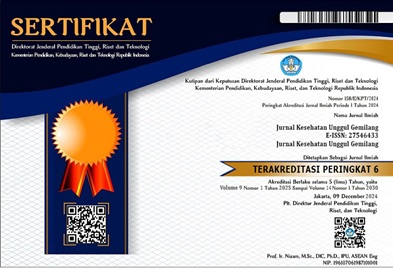IDENTIFIKASI DRUG RELATED PROBLEMS (DRPs) PADA PASIEN DEMAM BERDARAH DENGUE (DBD) DI INSTALASI RAWAT INAP PUSKESMAS GADINGREJO PRINGSEWU
Kata Kunci:
Demam Berdarah Dengue, Dengue, Masalah Terkait Obat, DRPsAbstrak
Demam Berdarah Dengue merupakan infeksi virus dengue yang ditularkan nyamuk Aedes Aegypti ke manusia. Drug Related Problems (DRPs) didefinisikan suatu kondisi terkait terapi obat yang potensial mengganggu hasil klinis yang diinginkan. Penelitian ini bertujuan untuk mengetahui karakteristik, profil pengobatan dan menganalisis persentase DRPs pasien DBD di Puskesmas Gadingrejo. Metode penelitian yaitu deskriptif non ekperimental, pengambilan data secara retrospektif menggunakan data rekam medik pasien rawat inap 2024 teknik pengambilan data secara purposive sampling, didapatkan 40 sampel yang sesuai kriteria inklusi. Hasil penelitian karakteristik pasien dari jenis kelamin paling banyak perempuan (55%), usia paling banyak adalah remaja usia 10-17 tahun (35%), dan kategori lama rawat inap 4-5 hari (72,5%). Sedangkan hasil kejadian DRPs yaitu (15%) pada kategori terapi obat tidak perlu terdapat 5 kasus dengan persentase 12,5% dan untuk kategori perlu terapi obat tambahan hanya ada 1 kejadian dengan persentase 2,5%, sedangkan pada kategori terapi obat tidak efektif, dosis terlalu rendah, dosis terlalu tinggi, efek samping obat dan ketidakpatuhan tidak ditemukan adanya kejadian DRPs atau tidak terjadi DRPs sebesar (85%).
Dengue Hemorrhagic Fever (DHF) is a dengue virus infection transmitted from mosquitoes (Aedes aegypti) to humans. Drug Related Problems (DRPs) are defined as conditions related to drug therapy that have the potential to interfere with the desired clinical outcomes. This research objective is to identify the characteristics, treatment profiles, and analyze the percentage of DRPs in DHF patients at Gadingrejo Public Health Center. The research method is descriptive and non- experimental, using retrospective data collection from the 2024 inpatient medical records. Data collection was conducted using purposive sampling technique, resulting in 40 samples that met the inclusion criteria. The research findings show that, based on patient characteristics, the majority were female (55%), the most common age group was teenagers aged 10–17 years (35%), and the most common length of hospitalization was 4–5 days (72.5%). The DRP findings revealed that 15% of patients underwent DRPs: 5 cases (12.5%) were categorized as unnecessary drug therapy, and 1 case (2.5%) was categorized as needing additional drug therapy. No DRPs were found in the categories of ineffective drug therapy, dose too low, dose too high, adverse drug reactions, or noncompliance—indicating no DRPs occurred in 85% of the cases.






